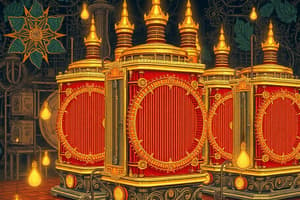Podcast
Questions and Answers
What are the primary components of a magnetic circuit?
What are the primary components of a magnetic circuit?
Magnetic materials, such as iron, soft steel, etc.
What is the unit of magnetic flux?
What is the unit of magnetic flux?
Weber (Wb)
What is the definition of permeability in the context of a magnetic circuit?
What is the definition of permeability in the context of a magnetic circuit?
Permeability is the ability of a material to allow the magnetic flux to pass through it.
Define reluctance in terms of a magnetic circuit.
Define reluctance in terms of a magnetic circuit.
What is the formula for calculating magnetic field intensity (H)?
What is the formula for calculating magnetic field intensity (H)?
What is the difference between a series and parallel magnetic circuit?
What is the difference between a series and parallel magnetic circuit?
What is leakage flux in a magnetic circuit?
What is leakage flux in a magnetic circuit?
Magnetic flux can be set up in a perfect vacuum.
Magnetic flux can be set up in a perfect vacuum.
The laws of magnetic circuits are analogous to those of electric circuits.
The laws of magnetic circuits are analogous to those of electric circuits.
A transformer can convert DC current into AC current.
A transformer can convert DC current into AC current.
What is meant by the "turns ratio" of a transformer?
What is meant by the "turns ratio" of a transformer?
What are the three primary classifications of transformers based on their construction?
What are the three primary classifications of transformers based on their construction?
What is the purpose of a "step-up" transformer?
What is the purpose of a "step-up" transformer?
Name the primary types of losses that occur within a transformer.
Name the primary types of losses that occur within a transformer.
How can we reduce iron losses in a transformer?
How can we reduce iron losses in a transformer?
How can we reduce copper losses in a transformer?
How can we reduce copper losses in a transformer?
Define the efficiency of a transformer.
Define the efficiency of a transformer.
What condition optimizes the efficiency of a transformer?
What condition optimizes the efficiency of a transformer?
What is voltage regulation in the context of a transformer?
What is voltage regulation in the context of a transformer?
What is the primary factor influencing the overall efficiency of a transformer?
What is the primary factor influencing the overall efficiency of a transformer?
What is the primary difference between an ideal transformer and a practical transformer?
What is the primary difference between an ideal transformer and a practical transformer?
Which phenomenon is NOT explained by wave optics?
Which phenomenon is NOT explained by wave optics?
What does the relationship $c = vλ$ represent?
What does the relationship $c = vλ$ represent?
Which region of the electromagnetic spectrum has the longest wavelength?
Which region of the electromagnetic spectrum has the longest wavelength?
How does the speed of light in a medium compare to its speed in a vacuum?
How does the speed of light in a medium compare to its speed in a vacuum?
Which of the following best describes the wave-particle duality of light?
Which of the following best describes the wave-particle duality of light?
What does Huygens' principle help to explain?
What does Huygens' principle help to explain?
Which statement accurately describes interference of light waves?
Which statement accurately describes interference of light waves?
What is primarily observed during diffraction of light waves?
What is primarily observed during diffraction of light waves?
Which type of light has oscillations in random directions?
Which type of light has oscillations in random directions?
How do diffraction gratings function in spectroscopy?
How do diffraction gratings function in spectroscopy?
What does wave optics significantly contribute to in modern technology?
What does wave optics significantly contribute to in modern technology?
What characterizes a wave in wave optics as opposed to traditional ray optics?
What characterizes a wave in wave optics as opposed to traditional ray optics?
In Young's double-slit experiment, the resulting interference pattern is primarily due to which phenomenon?
In Young's double-slit experiment, the resulting interference pattern is primarily due to which phenomenon?
Flashcards
Magnetic Circuit
Magnetic Circuit
A closed path that magnetic flux follows. Think of it as the path for magnetic lines of force.
Ideal Transformer
Ideal Transformer
An idealized transformer with no losses and perfect coupling between windings.
Transformer
Transformer
A device that transfers electrical energy from one circuit to another, typically changing the voltage and current levels.
Practical Transformer
Practical Transformer
Signup and view all the flashcards
Equivalent Circuit of a Transformer
Equivalent Circuit of a Transformer
Signup and view all the flashcards
Losses in a Transformer
Losses in a Transformer
Signup and view all the flashcards
Voltage Regulation of a Transformer
Voltage Regulation of a Transformer
Signup and view all the flashcards
Efficiency of a Transformer
Efficiency of a Transformer
Signup and view all the flashcards
Signup and view all the flashcards
Wave Nature of Light
Wave Nature of Light
Signup and view all the flashcards
Electromagnetic Nature of Light
Electromagnetic Nature of Light
Signup and view all the flashcards
Speed of Light
Speed of Light
Signup and view all the flashcards
Light Speed in Medium
Light Speed in Medium
Signup and view all the flashcards
Electromagnetic Spectrum
Electromagnetic Spectrum
Signup and view all the flashcards
Wave Optics
Wave Optics
Signup and view all the flashcards
Huygens' Principle
Huygens' Principle
Signup and view all the flashcards
Interference of Light Waves
Interference of Light Waves
Signup and view all the flashcards
Diffraction of Light Waves
Diffraction of Light Waves
Signup and view all the flashcards
Polarization of Light Waves
Polarization of Light Waves
Signup and view all the flashcards
Diffraction Gratings
Diffraction Gratings
Signup and view all the flashcards
Interferometers
Interferometers
Signup and view all the flashcards
Ray Optics
Ray Optics
Signup and view all the flashcards
Study Notes
Gateway Classes for Electrical Engineering (BEE101/201)
- This course covers Fundamentals of Electrical Engineering.
- Unit 3 focuses on Transformers.
- The syllabus includes magnetic circuits, ideal and practical transformers, equivalent circuits, losses in transformers, regulation, and efficiency.
- The course materials include topic-wise entire syllabi, long and short questions, AKTU previous year questions (PYQs), and DPPs (Daily Practice Problems).
- The content is result-oriented and includes video lectures.
Basic Definitions
- Magnetic Field: The area around a magnet within which its influence is perceptible.
- Magnetic Flux: The total number of magnetic field lines passing through a given surface. The unit is Weber (Wb), where 1 Wb = 10⁸ lines of force.
- Magnetic Flux Density (B): Flux per unit area. Formula: Flux/Area. Unit is Wb/m².
- Magnetic Field Intensity (H): Magnetizing force, or often referred to as magnetic field strength. It's the MMF (Magneto-motive force) required to magnetize a unit length of the magnetic flux path. Unit: AT/m.
- Magneto-motive Force (MMF): The cause of producing magnetic flux. It depends on the number of turns (N) and the current (I) flowing through the coil. MMF = NI, measured in ampere-turns (AT).
- Reluctance (S): The opposition that a magnetic circuit offers to the flow of magnetic flux. Reluctance (S) = MMF / Flux. Unit: AT/Wb.
- Permeance: The reciprocal of reluctance. The ease with which flux can pass through a material. Unit: Wb/AT.
Magnetic Circuit
- A magnetic circuit is a closed path followed by magnetic flux.
- Magnetic circuits are similar to electric circuits but involve magnetic materials with high permeability (e.g., iron, soft steel).
- The total reluctance of a series magnetic circuit is the sum of individual reluctances.
- The total magnetomotive force (MMF) for a series magnetic circuit is the sum of the MMF required for each part.
Similarities between Magnetic Circuit & Electric Circuit
- The closed path for magnetic flux is called a magnetic circuit, and the closed path for electric current is called an electric circuit .
- Flux corresponds to current, magnetomotive force (MMF) corresponds to electromotive force (EMF), reluctance corresponds to resistance, flux density corresponds to current density, magnetomotive force drop corresponds to voltage drop, magnetic intensity corresponds to electric intensity, and permeance corresponds to conductance.
Dissimilarities between Magnetic Circuit & Electric Circuit
- Truly speaking, magnetic flux does not flow. Flux is set up in the core.
- No magnetic insulators exist. Air is a good insulator for magnetic current.
- Magnetic field intensity varies significantly with flux density. Reluctance is not constant.
- No energy is expended in maintaining magnetic flux
Transformer Basics
- A transformer is a static electrical machine used to increase or decrease the voltage level of an AC supply while keeping the frequency constant.
- The basic principle of a transformer is mutual induction between two windings (primary and secondary) linked by a common magnetic flux.
Transformer Types
- Transformers can be classified based on construction (core type, shell type).
- They can be classified based on purpose (step-up, step-down).
- Also based on supply type (single or three phase).
Transformer Equivalent Circuit (referred to primary or secondary).
- Includes the resistances and leakage reactances. (Both primary and secondary.)
- This is used to study the behavior of the transformer under different loading conditions and voltage regulation calculations. The equivalent circuit shows the resistances and leakage reactances referred to the primary or secondary windings.
Transformer Losses
- Iron losses (core losses) are fixed and are primarily due to hysteresis and eddy currents.
- Copper losses are variable losses and are due to the resistance of primary and secondary windings.
Transformer Efficiency
- The efficiency of a transformer is defined as the ratio of output power to the input power.
- The maximum efficiency occurs at a load where copper losses equal iron losses.
Voltage Regulation of a Transformer
- Voltage regulation is the change in the secondary voltage from no-load to full load. Usually expressed as a percentage.
Additional Information
- Transformer ratings are often expressed in kVA (kilovolt-amperes).
- Various losses (copper, iron, etc.) and efficiency calculations are presented in numerous example problems.
- Concepts like magnetizing current, leakage flux, and fringing are also included in the detailed study notes.
Studying That Suits You
Use AI to generate personalized quizzes and flashcards to suit your learning preferences.




